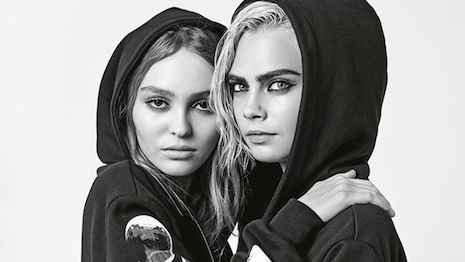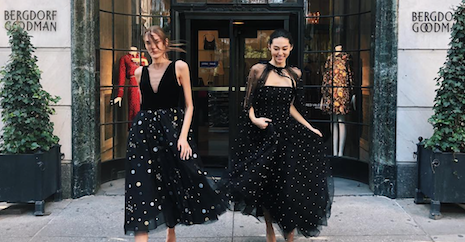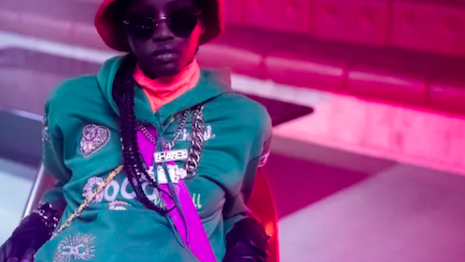 Gucci autumn/winter 2018 men's tailoring campaign with Harry Styles. Image courtesy of Gucci
Gucci autumn/winter 2018 men's tailoring campaign with Harry Styles. Image courtesy of Gucci
Luxury brands will no longer be able to overlook Generation Z, as these up-and-coming consumers acquire more social influence and earning power.
Having grown up under very different circumstances than millennials, Generation Z consumers are racially and culturally diverse and have never known a world without technology at their fingertips. Luxury marketers will need to turn to new strategies to attract these consumers who value authenticity and creativity above almost everything else.
“Gen Z doesn’t want brands to tell them a story – they want to help create the story,” said Yana Bushmeleva, chief operating officer at Fashionbi, Milan. “To engage a unique brand with Gen Z, marketers must understand that teenagers value participation in the advertising process.
“They are willing to partner with the brands they love, but it must be a two-way partnership – from mobile to digital to bricks-and-mortar,” she said.
Top five Generation Z luxury trends
- Coming of age
Most Generation Z consumers are younger than 18 years old, but the demographic is expected to make up a significant portion of consumers in the coming years. - Constant connection
Generation Z uses technology, smartphones and social media more frequently than any previous generation. - Shared values
Younger consumers are more likely to purchase from brands that share similar, forward-thinking values. - Experiential retail
Gen Z consumers appreciate bricks-and-mortar stores but expect omnichannel shopping experiences. - Tailored moments
From personalized offerings to unique experiences, Generation Z wants authentic connections with brands.
Who is Gen Z?
With millennials aging and acquiring more wealth, their younger Generation Z counterparts are quickly becoming the new trendsetters.
“Generation Z are now young adults, and many of them have entered the workforce,” said Gregg L. Witt, youth brand strategist and chief strategy officer of Engage Youth Co. and author of “The Gen Z Frequency: How Brands Tune In and Build Credibility,” San Diego, CA. “Marketers often clump this group together with millennials, but they’re not the same and marketers shouldn’t view them under the same lens.”
Chanel fall/winter 2017 featured Gen Z's Lily-Rose Depp and millennial Cara Delevingne. Image credit: Chanel
Market research firm Fashionbi defines three prominent generations as Generation X, born between 1965 and 1980, Generation Y, also known as millennials, born between 1981 and 1995 and Generation Z, born between 1996 and 2010.
According to A.T. Kearney, Gen Z is the first primarily minority generation, with whites comprising only 48 percent of the age group. Because of this greater diversity, these consumers do not make as many differentiations between races (see story).
Although the majority of Gen Z is still under 18, they are expected to make up 40 percent of all consumers by 2020. More digitally connected than millennials, these younger consumers check social media hundreds of times of a day and respond best to succinct brand messages (see story).
Additionally, Generation Z is more likely to be interested in and buy luxury goods than their millennial predecessors.
Data from InMarket shows that Gen Z customers frequent luxury retailers more often than millennials, who prefer discount brands. Despite their relative lack of wealth due to their age, Gen Z is also more likely to engage with luxury brands than their older counterparts (see story).
Digitally driven
Whereas millennials began using technology such as computers and social media in their youth and adolescence, members of Generation Z are true digital natives who did not experience the transition away from analog firsthand.
It is unsurprising then that Gen Zers have embraced social media at unprecedented levels.
Members of Gen Z typically spend a third of their day, or 7.6 hours, on social media. Gen Z is constantly checking and refreshing their social media feeds in short bursts, leaving less time for brands to be able to grab their attention (see story).
Gen Z consumers spend a third of their day on social media. Image credit: Facebook
Despite their impatience and short attention spans, Gen Z will still engage with branded content from advertisers – as long as it is entertaining and transparent.
“Gen Z has developed an ability to quickly filter the mass quantities of information that appear on their screens and decide what is worthwhile and what should be filtered and discarded,” Mr. Witt said. “Gen Z is less interested in mainstream platforms like TV and leans towards YouTube, Instagram and Snapchat.”
Data from Fullscreen shows that Gen Z consumes video almost six times as much as they consume traditional blogs and written content. Members of Gen Z also follow influencers on a variety of platforms at a rate of more than 50 percent (see story).
Compared to other generations, Generation Z consumers are particularly drawn to YouTube’s endless supply of visual content.
An episode of Vogue’s “73 Questions” series with Gen Z model, Bella Hadid
YouTube is the most popular platform among users ages 18 to 24, per data from Visual Objects. According to GenHQ, 47 percent of Gen Zers view more than three hours of content on YouTube on a daily basis (see story).
As advertisers become more interested in Generation Z, media groups such as Condé Nast are pushing forward with more investments into original video programming on YouTube. Condé Nast counts about 27 million subscribers across its YouTube channels (see story).
Recently, YouTube has been facing competition from Instagram as the social network pivots more towards video.
Although Instagram originally launched as a photo-sharing service, video has been part of the platform since 2013. More recently, Instagram Stories and IGTV have made the Facebook-owned network a major player in video advertising.
Unlike YouTube, IGTV is entirely focused on mobile-first video. IGTV videos are oriented vertically so that they fit better on mobile devices and the whole user interface is built for viewing on smaller screens (see story).
Bergdorf Goodman has created content exclusively for Instagram TV. Image credit: Bergdorf Goodman
While IGTV has yet to gain significant traction among consumers, Instagram is still the platform of choice for brands investing in influencer marketing to reach Generation Z.
According to data from marketing platform and data analytics company Launchmetrics, with 46 percent of fashion, beauty and luxury businesses prefer to use Instagram for influencer marketing. Eighty percent of brands in these industries report using influencer campaigns in the past year (see story).
Value appreciation
From authenticity and self-expression to sustainability and social justice, Generation Z shoppers seek brands with shared values when making purchasing decisions.
“Gen Z consumers today have made it very clear that brands having a purpose beyond profits matters, and brands taking a stand on today’s important social issues is paramount,” said Mary Noel, director of DoSomething Strategic, New York. “Luxury brands, especially, have an opportunity to leverage their platforms for good.”
Environmental causes are particularly of interest to younger affluents. Image credit: Moncler
As social norms seem to be shifting and important social conversations are at a high, a study by DoSomething.org found that 76 percent of Gen Z consumers have purchased or are open to buying from a brand based on the issues it supports. Many are now even seeking out brands, rather than finding them by happenstance, based on social causes.
About half claim to have recently purchased an item based on an issue affiliation in an effort to take a stand. Another 40 percent say they would cease business with a brand based on how aligned it is with their personal values (see story).
“As a global cohort, Gen Z is open to all ethnicities, races, genders and orientations,” Mr. Witt said. “They expect to see those values reflected in their brands, classrooms and media.”
The Estée Lauder x Kith collaboration spotlighted diversity and natural beauty. Image credit: Estée Lauder
Luxury brands are catching on and becoming more public about their own points-of-view and their corporate responsibility efforts.
Known for its inclusion and openness to the LGBTQ community as well as diversity as a whole, LVMH’s Sephora is taking steps to help transgender individuals gain confidence. As part of its Sephora Stands program, 90-minute classes are offered for non-binary and transgender customers to learn various techniques to help them discover their own idea of beauty and confidence (see story).
Through its Chime for Change initiative, Italian fashion label Gucci is fine-tuning its sights on gender equality with initiatives spanning various mediums, generations and communities, including its famous ArtWalls.
Gucci’s “The Future is Fluid” was created with Gen Z in mind
Gucci also released a film that spotlights gender equality, and focuses on what gender means to Generation Z across the world. Titled “The Future is Fluid,” it features interviews with individuals from Brazil, Canada, India, Italy, Singapore, South Africa, the UAE, the U.K. and the U.S. (see story).
“Gucci is one of the most wanted brands among Generation Z,” Fashionbi’s Ms. Bushmeleva said. “I believe this is due to the numerous musicians and rappers who are wearing the brand on a daily basis, and thanks to the creative content on social media and offline.”
Generation Z is also more cognizant of sustainability, and younger consumers are more aware of the challenges and ethical considerations relating to the fashion world.
In 2017, Kering launched a sustainability strategy based on three pillars, focusing on caring for the environment and people, collaborating to achieve goals such as gender parity and creating new ways of doing things. The conglomerate is working to reduce its carbon footprint by 40 percent by 2020, and it aims to be PVC free (see story).
Savvy shoppers
Similarly to millennials, Generation Z consumers have shifted away from products and towards experiences. This influences their shopping habits as well.
Generation Z remains drawn to the human touch found in the in-store experience. However, younger consumers still expect bricks-and-mortar retailers to be tech-forward, due to the presence of social media and digital marketing.
“They want all that the digital world can offer them, while also desiring IRL experiences, and also the opportunity to share what’s happening IRL digitally,” DoSomething’s Ms. Noel said. “Bottom line: they want a seamless and personal experience that meets them where they are.”
Mobile shopping continues to grow in popularity. Image credit: Estée Lauder
Rather than eschewing traditional retail entirely for ecommerce, Gen Z is instead seeking bricks-and-mortar stores that incorporate technology and seamless omnichannel shopping.
According to a study by the National Retail Federation and IBM, 67 percent of Gen Z consumers do most of their shopping in stores as opposed to online. However, mobile devices are an integral part of the shopping experience for these consumers.
About 55 percent of Gen Z shoppers use their phones to look up price comparisons, and 51 percent look for discounts and promotions. Young consumers are also using their smartphones to look up items that are not in featured in a store, for product comparisons and communication in regards to shopping (see story).
At this point in their lives, Gen Z consumers are forming their opinions of retailers, and they are open to experimentation.
Brand loyalty among Generation Z is up for grabs, with eight in 10 seeking out new stores according to a report from Criteo. Personalization is also key, as 62 percent appreciate targeted online advertising for products.
When it comes to bricks-and-mortar shopping, 71 percent look to physical retail as a source of style inspiration. They most value store design and unique merchandise selections when shopping in-store (see story).
Gen Z shoppers expect technology to facilitate retail experiences. Image Credit: Alibaba
In addition to appreciating targeted online advertisements, members of Generation Z also crave personalization in the form of limited-edition merchandise, uncommon or customized products and personalized experiences.
A report from media group Condé Nast found Sephora is a Gen Z-favorite for successfully tailoring in-store and online shopping experiences to different consumers.
The beauty retailer delivers the personalization that these consumers crave, whether enabling virtual try-ons via smart mirrors and smartphone screens or customizing a shopper’s browsing experience. The in-store environment is also aimed at providing a hands-on experience, allowing consumers to interact with products through guided workshops and in-store technology (see story).
“In today’s digital world, when shopping it’s become easy to feel less connected with communities in our physical reality and more engaged with those that social and digital technologies provide,” Engage Youth Co.’s Mr. Witt said. “With every new app, device and technology, the digital dominance grows, while actual, real-life human and social interaction has, in many ways, been eclipsed.”
Additionally, Generation Z consumers make more online clothing purchases than other age groups, but look for retailers who emphasize flexibility.
Tamara Mellon offers installment payment plans. Image credit: Tamara Mellon
More than a third of Gen Z consumers are interested in installment plans as they desire upscale clothing outside of their budgets, according to a shopping behavior report from Klarna. A quarter of Gen Z shoppers are most influenced to buy a particular item when it is “trending,” and 26 percent have been interested in a piece they have seen on social media (see story).
Streetwear and casual wear, such as sneakers, also continue to grow in popularity as an entry point into luxury apparel.
Younger consumers are more willing to experiment with new brands within the casual wear category, particularly through online shopping.
Seventy percent of Generation Z have made casual wear purchases, according to CPC Strategy. More than a third of Gen Z consumers have also bought apparel directly on a brand Web site, compared to an average of 25 percent across all other generations (see story).
Clothing collaborations, especially those with a streetwear appeal, are also finding favor among Generation Z.
Chanel has teamed with Pharrell Williams on a collection. Image credit: Chanel
According to research from BCG and Altagamma, millennials and Gen Z shoppers are more aware of collaborations than older shoppers, and more than six in 10 of these consumers have purchased items from a special-edition.
Some of the most popular recent collaborations for true-luxury buyers were Louis Vuitton and Supreme, Adidas and Yeezy, Chanel and Pharrell and Fendi and Fila. Consumers were most likely to scoop up handbags or sneakers from a one-off alliance (see story).
“Gen Z has learnt early in life the importance of collaboration in both local and distributed, or virtual, environments,” Mr. Witt said.
Best practices
- Yana Bushmeleva, chief operating officer at Fashionbi:
- “Brands will have to create products and marketing that empower these teens to be their best selves. Gen Zers judge their favorite brands on how well each contributes to their personal brand. For example, does the brand reflect their values of inclusiveness and innovation?”
- “Brands also need to find alternative influencers and PR activities.”
- Gregg Witt, chief strategy officer at Engage Youth Co.:
- “It all starts with having an identity that young people care about, especially when it comes to attracting streetwear, luxury or a convergence of audience groups. To find that identity, you need to go far beyond your service, product and packaging and really determine who you are and what you represent to Gen Z. It’s the differentiator between successful brands, with strong audiences and proven staying power, and those that struggle to find their path.
- “With a genuine, compelling and entrenched foundation, your brand can withstand the ups and downs of the market or trend cycles. Once you’ve established your identity, stay committed to your core principles and beliefs – know what is non-negotiable and what can morph and evolve with your audience.”
- Mary Noel, director at DoSomething Strategic:
- “Leverage cause as an authentic brand expression by delivering on what you promise, not just talking about it in your social posts and in your ads. It’s about doing the right thing. And about giving your employees and consumers alike an opportunity to be engaged in the effort rather than just pushing out marketing messages.”
- “For luxury brands right now, the social impact point of differentiation is all white space. It is an opportunity to create a community, not just a transaction.”








